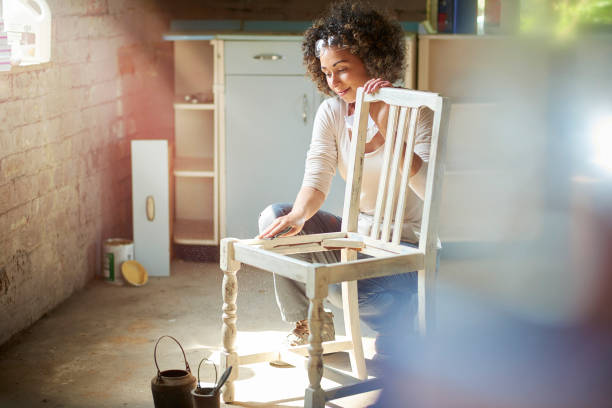Easy DIY Projects You Can Try at Home
Learn how people create fun and useful things on their own with simple materials and tools. This article explains step-by-step ways to plan, build, and complete DIY projects. Discover how ideas turn into finished items and enjoy learning how things are made from start to finish.

Simple DIY Woodworking Projects for Beginners
Woodworking might seem intimidating at first, but several projects are perfect for novices. A floating shelf is an excellent starter project requiring only basic tools—a saw, drill, sandpaper, wood stain, and brackets. Begin with pre-cut lumber from your local hardware store to simplify the process. Another accessible project is a rustic picture frame, which teaches fundamental woodworking skills like measuring, cutting angles, and joining wood pieces. For those wanting something more functional, consider building a basic wooden stool or side table. These projects teach essential woodworking techniques while producing practical items for your home.
Home Improvement DIY Projects That Add Value
Transform your living space with impactful home improvement projects. Refreshing wall paint remains one of the most cost-effective ways to dramatically change a room’s appearance. Consider accent walls for added visual interest without overwhelming commitment. Installing new cabinet hardware in kitchens and bathrooms offers another quick upgrade with minimal tools required. For moderate skill levels, installing peel-and-stick backsplash tiles provides the look of a professional renovation without the complexity of traditional tile work. Homeowners comfortable with basic electrical work might consider replacing outdated light fixtures, instantly modernizing spaces while potentially improving energy efficiency.
Weekend DIY Home Projects for Various Skill Levels
Weekend warriors can accomplish meaningful home projects regardless of experience level. For beginners, creating a vertical garden using recycled pallets maximizes growing space while adding visual appeal to patios or balconies. Those with some experience might tackle refinishing furniture, breathing new life into thrift store finds or family heirlooms. More advanced DIYers could install board and batten wall treatments, adding architectural interest to plain walls. Another popular weekend project is building raised garden beds, which combines basic woodworking skills with the satisfaction of growing your own produce or flowers—perfectly blending functionality with aesthetic improvement.
Easy DIY Crafts Using Common Household Items
Creative crafts don’t always require special materials or tools. Making decorative mason jar lights involves simply adding string lights to cleaned glass jars, creating ambient lighting for patios or indoor spaces. Homemade candles require just wax, wicks, containers, and optional fragrance oils—perfect for personalized gifts or home decor. For wall art, consider creating abstract paintings using painter’s tape to create geometric patterns, then applying acrylic paint in complementary colors. Fabric crafts like no-sew pillow covers transform outdated spaces with minimal effort, requiring only fabric, scissors, and iron-on hem tape. These projects demonstrate that impressive results don’t necessarily require extensive crafting experience.
Essential Tools and Materials for Home DIY Projects
Building a foundational toolkit supports diverse DIY endeavors. Basic tools include a claw hammer, set of screwdrivers (flathead and Phillips), tape measure, level, utility knife, and adjustable wrench. For those pursuing woodworking, add a cordless drill, handsaw, and sanding supplies. Safety equipment remains essential regardless of project complexity—safety glasses, work gloves, and dust masks protect during most DIY activities. Regarding materials, maintain basics like various screws and nails, wood glue, painter’s tape, and multi-surface primer. As skills develop, consider investing in power tools like circular saws or sanders, which expand project possibilities while reducing physical effort. Remember that quality tools, while initially more expensive, typically offer better performance and longevity.
Cost Breakdown of Popular DIY Home Projects
Understanding potential costs helps in planning projects effectively. Below is a comparison of common DIY projects with their estimated material costs and complexity levels:
| DIY Project | Materials Cost Range | Complexity Level | Time Investment |
|---|---|---|---|
| Floating Shelves | $25-$75 | Beginner | 2-4 hours |
| Accent Wall Painting | $30-$100 | Beginner | 4-6 hours |
| Refinished Furniture Piece | $40-$120 | Intermediate | 1-2 days |
| Board and Batten Wall | $100-$250 | Intermediate | 1-2 days |
| Built-in Bookshelf | $150-$400 | Advanced | 2-3 days |
Prices, rates, or cost estimates mentioned in this article are based on the latest available information but may change over time. Independent research is advised before making financial decisions.
Turning DIY Skills Into Sustainable Home Practices
DIY projects often introduce sustainable living concepts through repurposing and upcycling. Creating compost bins from wooden pallets promotes garden health while reducing kitchen waste. Repurposing glass containers into storage solutions or decorative items prevents additional consumption. Learning basic home maintenance—like fixing leaky faucets or sealing drafty windows—reduces resource consumption while developing practical skills. Many DIYers find that completing initial projects builds confidence for tackling increasingly complex home improvements, potentially saving thousands in contractor costs over time. This progressive skill development represents perhaps the most sustainable benefit of embracing do-it-yourself projects.
The journey into DIY projects offers more than just finished products—it provides skill development, creative expression, and a sense of accomplishment. Whether undertaking simple crafts or more ambitious home improvements, the process of creating and improving spaces with your own hands delivers satisfaction beyond the monetary value of completed projects. By starting with simpler endeavors and gradually building skills, anyone can successfully incorporate DIY approaches into their home environment.




